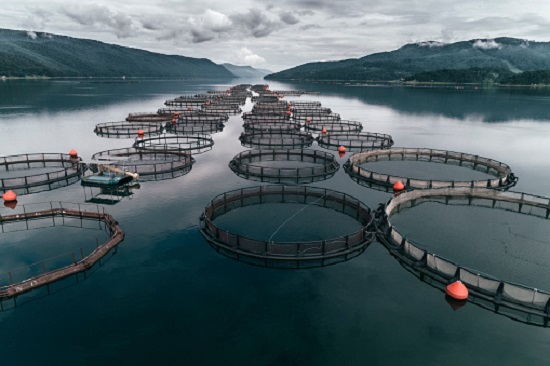By – IAIDL Staff
Fish farmers in Norway are using AI models designed to cut costs and improve the efficiency of their efforts to raise salmon, one of the country’s major exports, thanks to efforts of the Norwegian Open AI Lab.
The efforts are part of a growing trend to apply AI automation to aquaculture, which is the farming of fish, crustaceans, mollusks, aquatic plants, algae and other organisms.
The AI models are designed to optimize feeding, keep the fish clean and healthy, and help companies make better decisions regarding farm operations, according to an account in WSJ Pro. The Norwegian Open AI Lab is run by Norwegian telecommunications carrier Telenor AS A, which along with other companies, provides technology services such as testing of 5G mobile connectivity, to salmon farms.
Salmon exports in 2019 totaled some $11.3 billion, according to the Norwegian Seafood Council. Representing fisheries and fish farm industries, the trade group reported that fish exports increased about one percent between January and August 2020.
Under pressure to improve environmental standards and reduce waste, the industry has been working with tech companies to start providing AI tools to Norway’s fish farms.
For example, Alphabet Inc.’s Tidal initiative is partnering with seafood company Mowi AS A to use AI to analyze and monitor fish and environmental conditions. Microsoft, Swiss engineering firm ABB Ltd. and fish farm operator Norway Royal Salmon ASA are piloting an AI solution to remotely track fish populations. And IBM has created a machine-learning tool that predicts outbreaks of sea lice, which are parasites that threaten farmed fish.
The Norwegian Open AI Lab has based its AI initiatives on neural networks, which learn based on large sets of training data, and a type of AI known as “tiny machine learning,” which encompasses hardware and software capable of performing on-device sensor data analytics at extremely low power.

One of the neural network applications is designed to help fish farm workers understand salmon feeding behavior. It analyzes data from underwater cameras to determine behavior changes that signal the fish are no longer hungry, according to Bjørn Taale Sandberg, head of Telenor Research. Some 40% of the cost of fish farming is in feed.
The company is also developing small computers that could remain on site at a fish farm and eventually make decisions automatically based on what cameras detect. The computers use “tiny machine learning,” which can be especially useful for remote fish farms where the internet networks might not be strong. The system could automate some decisions without connecting to the shore, reducing manual labor required to monitor the farm.
“In the ocean or in a wild fiord, you want to avoid the number of times you visit the farm to check for problems,” Sandberg stated.
Opportunity for AI in Aquaculture Attracting Startups
The trend of increased application to AI to aquaculture has attracted some startup firms who see an opportunity, as outlined in a recent account from The Fish Site.
For example, Observe Technologies offer to track measurable patterns when stocks are feeding. Their goal is to provide farmers empirical and objective guidance on how much to feed. The system aggregates data from sources including sensors, cameras, and acoustics, then extracts relevant information for its algorithms, and sends alerts to farmers for when to increase or decrease feeding. The software learns as it goes, getting smarter over time, and can be operated remotely.
Another player called eFishery has developed a system which uses sensors to detect hunger levels in shrimp and fish, controlling dispensers which release the right amounts of food; the company claims this can reduce feed costs by up to 21%. Founded in 2013, the company is based in Indonesia.
Elsewhere, Japanese and Singaporean aquaculture technology firm Umitron Cell offers a smart fish feeder which can be controlled remotely. “Farmers are given data-driven decision-making advice to optimize feeding schedules. This reduces waste, improves both profitability and sustainability while offering users a better work-life balance by eliminating the need to be out in the water in dangerous conditions,” stated Umitron product manager Andy Davison.
Among its recent projects, Umitron is leading a project to develop a data platform for shrimp farming in the ASEAN region by using IoT and AI technologies. The project aims to improve shrimp farming productivity and working conditions while conserving the natural environment.
The company also recently announced the Pulse mobile application for Android users, to provide a high-resolution ocean map of critical environmental parameters such as water temperature, chlorophyll, dissolved oxygen, salinity and wave height.
Startup XpertSea focuses on optimizing the economics of harvesting, which most farmers gauge based on educated guesses. The company’s product uses computer vision and AI to calculate the growth of shrimp, helping farmers predict the most profitable harvest periods. Deep learning techniques are used to pinpoint timeframes by continuously using machine learning on historical growth cycle data.

“The company’s Growth Platform provides online management software which uses AI to capture, ingest, store and process field data to give farmers and industry experts actionable, data-driven insights throughout the whole production cycle,” stated Valérie Robitaille, CEO of XpertSea. “This platform is used by farmers but also feed, health, genetics, and certification enterprises to provide data-driven services to farmers.”
Another part of the product, XperCount, collects critical animal data by using cameras and machine learning which is applied to count, size, and weigh animals in seconds.
The company reports having over 600 farmers and other customers, and in the past year has processed over 2.3 billion animal data points and optimized the performance of 6,000 crops.
Strides are being made in the automation of aquaculture to produce more seafood to feed the world population while residing the environmental footprint of operations.
Read the source articles in WSJ Pro and The Fish Site.

